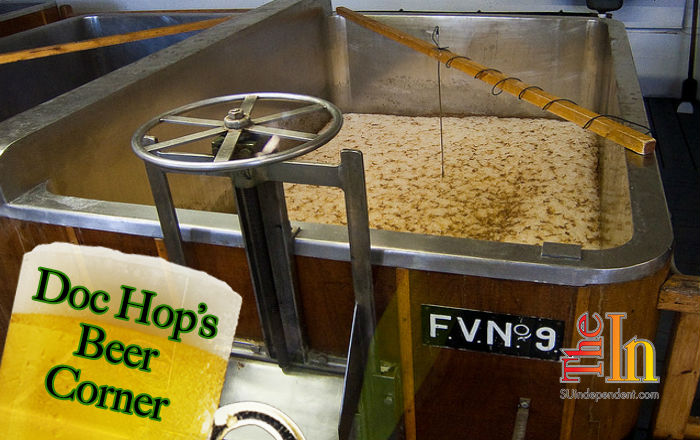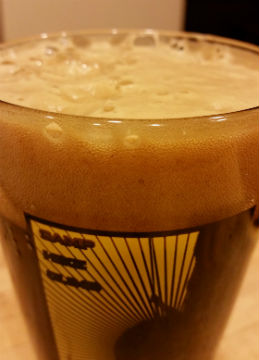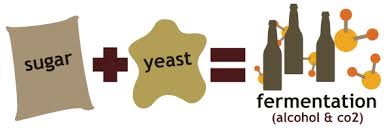 Written by Jeremy Hopkin
Written by Jeremy HopkinWe are going to start this article off by reviewing the tasting of our last beer – EPICS Brainless Belgian blond ale. Hopefully you have a good recollection or notes of your tasting. Here are my impressions of this beer. Although I’ve had this beer many times, it was nice to step back a bit and take some time to try to tease out all the flavors. I also tasted it with some friends, who got other impressions and tastes from it altogether. Here is what I came up with.
Appearance: Light yellow to caramel color with full clarity. Pours clear releasing carbonation quickly and finishes with a white small non-foamy head. Head dissipates quickly.
Taste/Aroma: Citrus and floral aroma with very faint ester/alcohol smells of nail polish remover. Initial flavors of grapefruit and honey which quickly shifts into a mild bitterness. Slight metallic flavor.
Mouth feel. Moderate viscosity with high carbonation level. Alcoholic warming as you swallow first mouthful.
Overall impression: An easy drinking, pretty high alcohol fusion beer. This one could get you in trouble fast! The mild hop bitterness at the end of the swallow makes you ready to take the next sweet gulp quickly. Hop level is higher than a typical Belgian Trippel giving some pleasant mild bitterness and fruity hop aromatics, but masking some of the typical aromas and flavors of Belgian style yeasts. I like this fusion, as I am more partial to hop flavors/bitterness but it is not the best representation of a Belgian Trippel and definitely tastes more like a strong blonde Ale. If this is what they were aiming for- I think they nailed it. 7/10 overall score from me.
During our tasting session there were many other comments of flavors and smells. Some reported a very strong floral smell with almost no citrus, although most people commented on citrus notes. Some thought the beer was very bitter, while others thought there was almost no bitterness. This seemed to depend on whether or not the taster was partial to highly hopped beers.
Unfortunately, I don’t think my first selection highlighted yeast as much as I had hoped. As I mentioned above, I think this is a good fusion beer but the impact of yeast flavors compared to a Belgian Trippel is very subdued. For a true representation of flavors imparted by yeast at high temperature/alcohol brewing, grab a true Belgian trippel like Delirium Tremens or Duvel. They are pretty pricy, but you will get an explosion of yeast-derived flavors from these beers. Some typical flavors people describe from Belgian yeasts are spicy, pepper, clove, citrus and even sometimes banana and bubble gum.
 As I alluded to above most Belgian beers are low in hop levels and are highly fermented –minimizing any grain or malt flavors. This allows flavors derived from yeast to predominate.
As I alluded to above most Belgian beers are low in hop levels and are highly fermented –minimizing any grain or malt flavors. This allows flavors derived from yeast to predominate.
The knowledge of yeast and development of strains is a relatively recent occurrence in the world of brewing.
For many centuries, drinks were fermented into alcohol by spontaneous fermentation – meaning that the initial fermentable sugary fluid – regardless of the origin (fruit, grain, cactus) – was left open to the air. Although now we know that the fluid is inoculated by wild yeast strains and bacteria drifting by in the wind, back in the day all that was known was that the juice was transformed into booze! Truly a miracle to people back then.
It is no coincidence that ancient Sumerians had a goddess of beer and that monks of middle ages considered fermentation a gift from god. I mean – how could you not! Leave some gruel out for a bit and presto you get an inebriating beverage that stores well and has many additional nutritional benefits like added B vitamins and amino acids. In a world beset with nutritional deficiencies and many daily harsh realities (Viking marauders, lice, pestilence and such) you can imagine what a wonderful diversion a good rolling buzz was.
As with so many other natural processes ascribed to supernatural beings or benevolence – the advance of science has been able to shed some light on the subject. Just as knowing the true origin of a sunrise in no way reduces its beauty and majesty, any brewer can attest to the fact that understanding fermentation in no way takes away the undeniable fact that fermentation is a deeply inspired, even rapturous event.
The first major steps in understanding came with early microscopists – who would literally put anything under a microscope and look at it (i.e. – see early microscopists essays on the microstructure of dung, sheep ejaculate, and rotting flesh). Fun bunch of fellows!
Anton von Leeuhook first observed and described moving objects in fermenting beer, but Luis Pasteur is considered the first person to ascribe the process of fermentation to the small living organism.
This initial discovery eventually led to isolation of the organism and propagation of strains. Classifying the organism was much more of a challenge. Was it a plant, fungus, a very small animal or something entirely different? This small single cell organism actually has characteristics of all, but was eventually classified as a fungus. We now have a very good basic understanding of what is happening inside that organism, but many of the finer intricacies of yeast metabolism and propagation still elude our best investigations.

On a basic level, yeast takes a sugar molecule and metabolizes it into alcohol and carbon dioxide. Chemical equation = C6H12O6 → 2 C2H5OH + 2 CO2. This is a highly simplified version of what actually happens. The exact process is much more complicated when you have longer chain sugars and other forms of sugar molecules.
The metabolism of sugar is also highly dependent on temperature. In fact, our recently tasted style of beer – Belgian trippel style – deliberately ferments at a higher temperature. This tends to stress the yeast into producing other chemicals – esters, phenols, and other types of alcohol other than ethanol. This includes fusel alcohols (more carbon atoms than ethanol), minor amounts of methanol (single carbon atom). All of these chemicals have distinct flavors.
Esters typically produce fruit like flavors and phenols spicy or clove like flavors. While fusel alcohols are usually avoided due to harsh flavor (and the possibility to harsh hangovers!), in small amounts, they can add floral, almost wine like flavors.
As you can see, yeast is the absolute lynchpin of making beer, and in some cases is also the main player in the taste of a beer. We will taste other beers that have almost no contribution of flavor from yeast. This doesn’t mean its not working hard. It always is, but a brewer can choose other strains of beer and fermentation temperatures to limit its flavor contribution.
If yeast is the engine, then malted barley is the gas. It provides the fuel for creating alcohol. This next week we will be a tasting a beer with a much heavier malt backbone. Its flavors will be quite different and distinct from the beer we tried last time around. The same rules for tasting apply. Clean glass, clean palate, open mind and a nice cold brew! We will be tasting moose drool brewed by big sky brewing company. This malty beer is available in the can or bottle at most liquor stores. If you can’t find this one for some reason, pick up a different brown ale or as a last resort find an amber ale.
Cheers,
Doc Hop
 Jeremy Hopkin grew up in the heart of happy valley (Orem, UT). He received his undergraduate degree in zoology, got his M.D. degree from University of Utah, and did his residency in radiology at Dartmouth including a fellowship in neuroradiology. He is currently employed locally as a diagnostic radiologist and also treats varicose vein disease at Red Sands Vein and Laser Institute. He gives training and nutritional advice to athletes of all ages, shapes and sizes at Crossfit St. George and loves to help people attain their health goals. He is fascinated with science and is a tinkerer in all things fermentation. He’s been a home brewer for 7 years and is a beer lover for life! For questions or comments, Jeremy can be reached at [email protected]
Jeremy Hopkin grew up in the heart of happy valley (Orem, UT). He received his undergraduate degree in zoology, got his M.D. degree from University of Utah, and did his residency in radiology at Dartmouth including a fellowship in neuroradiology. He is currently employed locally as a diagnostic radiologist and also treats varicose vein disease at Red Sands Vein and Laser Institute. He gives training and nutritional advice to athletes of all ages, shapes and sizes at Crossfit St. George and loves to help people attain their health goals. He is fascinated with science and is a tinkerer in all things fermentation. He’s been a home brewer for 7 years and is a beer lover for life! For questions or comments, Jeremy can be reached at [email protected]



